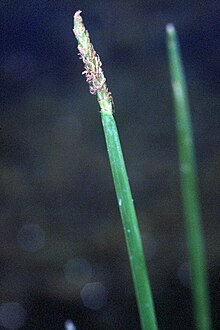
Fouquieria splendens is a plant indigenous to the Sonoran Desert and Chihuahuan Desert and Colorado Desert in the Southwestern United States, and northern Mexico.

Prunus serotina, commonly called black cherry, wild black cherry, rum cherry, or mountain black cherry, is a deciduous tree or shrub of the genus Prunus. Despite being called black cherry, it is not very closely related to the commonly cultivated cherries such as sweet cherry, sour cherry and Japanese flowering cherries which belong to Prunus subg. Cerasus. Instead, P. serotina belongs to Prunus subg. Padus, a subgenus also including Eurasian bird cherry and chokecherry. The species is widespread and common in North America and South America.

Eleocharis is a virtually cosmopolitan genus of 250 or more species of flowering plants in the sedge family, Cyperaceae. The name is derived from the Greek words ἕλειος (heleios), meaning "marsh dweller," and χάρις (charis), meaning "grace." Members of the genus are known commonly as spikerushes or spikesedges. The genus has a geographically cosmopolitan distribution, with centers of diversity in the Amazon Rainforest and adjacent eastern slopes of the South American Andes, northern Australia, eastern North America, California, Southern Africa, and subtropical Asia. The vast majority of Eleocharis species grow in aquatic or mesic habitats from sea level to higher than 5,000 meters in elevation.
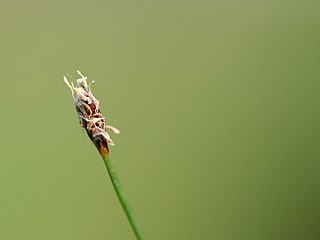
Eleocharis acicularis is a species of spikesedge known by the common names needle spikerush and least spikerush. It is widespread across Europe, central and southeastern Asia, North America and northeastern South America as far south as Ecuador. It is also found in Australia, where it is probably an introduced species.
Eleocharis vivipara is a species of flowering plant in the sedge family known by several common names, including umbrella hairgrass, sprouting spikerush, and viviparous spikerush. It is native to the southern United States from eastern Texas to eastern Virginia. It takes the form of a clump of thin stems. A spike of flowers appears at the tip of the stem. The plant may also reproduce by growing a plantlet and runners.
Eleocharis atropurpurea is a species of spikesedge known by the common name purple spikerush. This is an aquatic plant native to much of. It also has a wide distribution in temperate regions of North and South America and Asia. It is present in Europe, where it may be an introduced species for the most part.
Eleocharis geniculata is a species of spikesedge known by several common names, including bent spikerush and Canada spikesedge. This is a widespread plant of wet areas in the Americas, Asia, Africa, Australia, Madagascar, and some Pacific Islands. It is an annual spikesedge growing to a maximum height of about 40 centimeters. It has a few straw-colored leaves and many thin erect stems. The stems hold inflorescences of rounded spikelets each containing at least 10 tiny flowers. The flowers are covered with dark greenish-brown bracts. The fruit is a shiny purple-brown achene not more than a millimeter long.
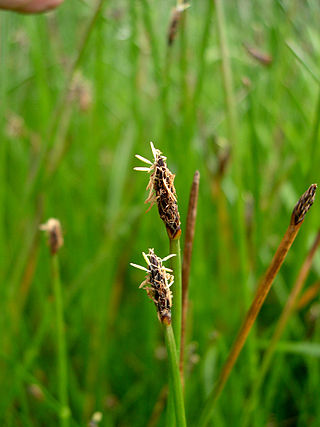
Eleocharis macrostachya is a species of spikesedge known by the common name pale spikerush.

Eleocharis quinqueflora is a species of spikesedge known by the common names fewflower spikerush and few-flowered spike-rush. It is widespread across Europe, North Africa, northern Asia, and North America. There are also isolated populations in Argentina and Chile.

Eleocharis palustris, the common spike-rush, creeping spike-rush or marsh spike-rush, is a species of mat-forming perennial flowering plants in the sedge family Cyperaceae. It grows in wetlands in Europe, North Africa, northern and central Asia and North America. Eleocharis palustris is not easily distinguished from other closely related species and is extremely variable worldwide itself. The species epithet palustris is Latin for "of the marsh" and indicates its common habitat.
Eleocharis montevidensis is a species of spikesedge known by the common name sand spikerush. It is a widespread coastal plant native to the Americas. It grows in moist, sandy spots in many habitat types, including lakes, riverbanks, wet meadows, and springs. It has a disjunct distribution, in North America and South America.

Eleocharis parishii is a species of spikesedge known by the common name Parish's spikerush.

Eleocharis parvula is a species of spikesedge known by the common names dwarf spikerush, small spikerush and hairgrass in aquaria. It is a plant of brackish and saltwater habitat, such as marshes and mudflats. It is a perennial herb growing tufts of spongy, compressible stems not more than 10 centimeters tall. The plant grows from a tuber which is J-shaped or horseshoe-shaped, a characteristic that helps in the identification of the species. The inflorescence is an oval-shaped spikelet just 2 or 3 millimeters long, made up of several tiny flowers.

Eleocharis rostellata is a species of spikesedge known by the common name beaked spikerush. It is widespread across North America, with isolated populations in Argentina.

Eleocharis torticulmis is a rare species of flowering plant in the sedge family known by the common names twisted spikerush and twist-stem spikerush. It is endemic to Plumas County, California, where it is known from two locations within a kilometer of each other in the Butterfly Valley Botanical Area. It grows in open wet habitat such as fens and meadows. It was separated from Eleocharis suksdorfiana and described to science as a new species in 2001.

Scirpus ancistrochaetus is a rare species of flowering plant in the sedge family known by the common names barbedbristle bulrush and northeastern bulrush. It is native to the northeastern United States from New Hampshire south to Virginia. It used to be found in Quebec but it is now thought to be extirpated there. It was also believed extirpated from the state of New York, but at least one population has been rediscovered in Steuben County in 2010. It is threatened by the loss and degradation of its wetland habitat. It is a federally listed endangered species.
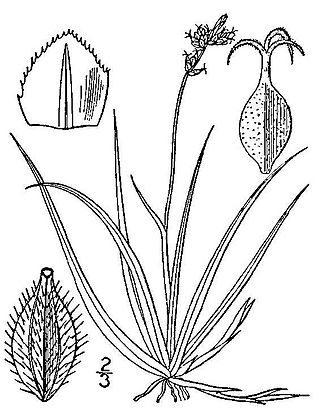
Carex concinna is a species of sedge known by the common names low northern sedge, northern elegant sedge, beauty sedge, and beautiful sedge. It is native to northern North America, where it occurs across Canada and in high elevations in the northern contiguous United States.
Eleocharis tuberculosa, the cone-cup spikerush, is a plant species native to the United States and Canada. It has been reported from every state on the Gulf and Atlantic coasts from Maine to Texas, plus Kentucky, Tennessee, Arkansas and Nova Scotia. It is found in wet soil in meadows, woodlands, lake shores and river banks.

Agave coetocapnia is a species of flowering plant in the family Asparagaceae, native to Mexico. It was first described in 1824 as Bravoa geminiflora. It has been known by several other scientific names, including, in whole or part, Polianthes geminiflora. It has been cultivated as an ornamental plant.
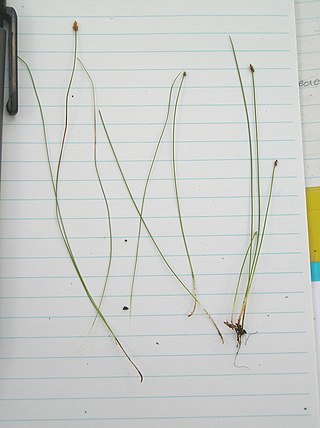
Eleocharis nitida is a species of flowering plant commonly called neat spikerush, it is a member of the sedge family Cyperaceae.
